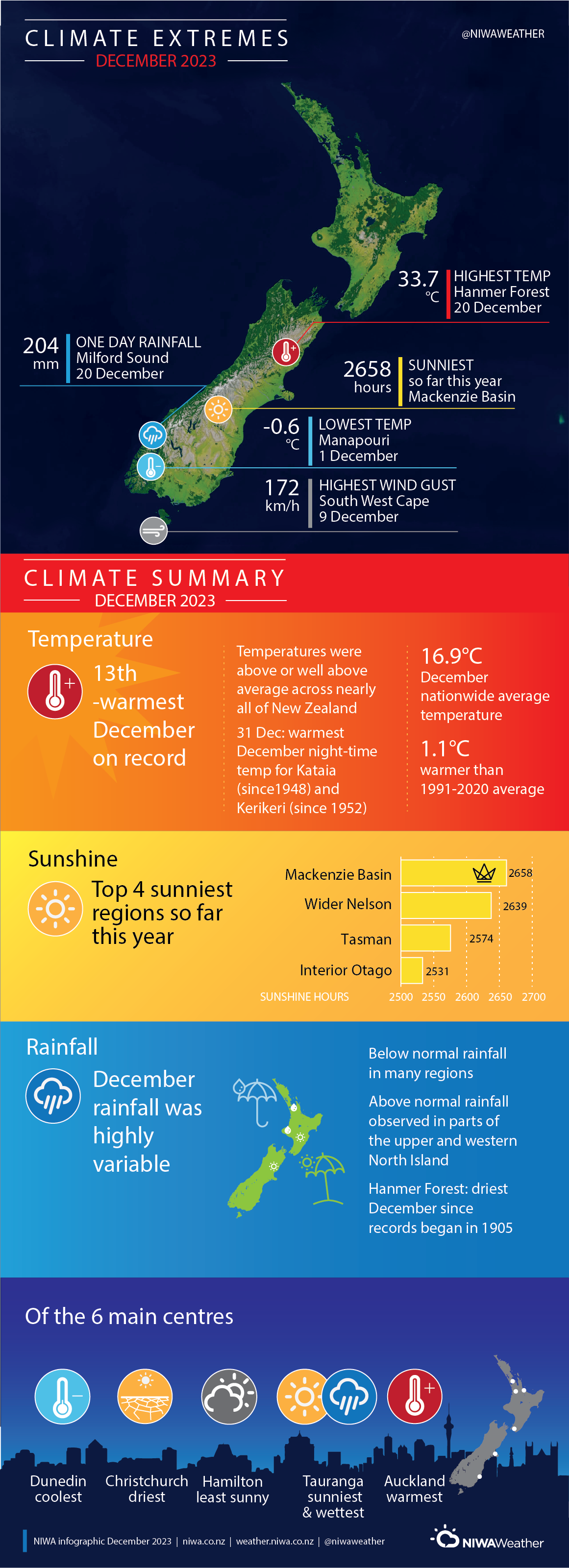A warm month with variable rainfall patterns
|
Temperature |
Temperatures were above average (0.51°C to 1.20°C above average) or well above average (>1.20°C above average) across nearly all of New Zealand. However, near average temperatures (±0.50°C of average) were observed in small portions of coastal Wellington, Marlborough Sounds, and Southland. |
|
Rainfall |
Rainfall was above normal (120-149% of normal) or well above normal (>149% of normal) in western Northland, much of Auckland, western and interior Waikato, Gisborne, and much of the immediate West Coast. Below normal (50-79% of normal) or well below normal (<50% of normal) rainfall was observed in eastern Northland, parts of the Coromandel and Bay of Plenty, southern Hawke’s Bay, Manawatū-Whanganui, Wairarapa, Nelson, Marlborough, northern and interior Canterbury, and interior Otago. Near normal rainfall (80-119% of normal) was observed elsewhere. |
|
Soil Moisture |
At the end of December, soil moisture levels were higher than normal across the Far North, Auckland, much of Waikato, Bay of Plenty, Gisborne, northern Hawke’s Bay, and parts of Tasman and the West Coast. Below normal soil moisture was observed in coastal Manawatū-Whanganui, Wellington, Marlborough Sounds, northern Canterbury, and eastern Southland. Elsewhere, soil moisture levels were generally near normal. |
Overview
December 2023 was characterised by higher than normal mean sea level pressure (MSLP) located north and east of Aotearoa New Zealand. This produced more north-westerly airflows than normal, particularly over the North Island. This contributed to above average or well above average temperatures across nearly all of the country in December. A particularly moist and humid air mass from the subtropics affected the North Island in the last ten days of the month, resulting in periods of heavy rainfall across the upper portion of the island. Perhaps the most impactful event during the month was a large severe thunderstorm that tracked north across the eastern South Island and lower North Island on 12 December, bringing heavy rain, strong winds, and large hail. Wellington’s Hutt Valley was particularly hard-hit, where multiple buildings were severely damaged by strong winds, localised flooding and hailstones up to 12 mm in diameter were observed, and more than 2,000 properties were left without power (see Highlights and extreme events section for more details).
![Mean Sea Level Pressure (MSLP) anomaly map for December 2023 [NIWA].](/sites/default/files/inline-images/MSLP_Dec2023.png)
Temperatures were above average (0.51°C to 1.20°C above average) or well above average (>1.20°C above average) across nearly all of New Zealand. However, near average temperatures (±0.50°C of average) were observed in small portions of coastal Wellington, Marlborough Sounds, and Southland.
The nationwide average temperature in December 2023 was 16.9°C. This was 1.1°C above the 1991-2020 December average from NIWA’s seven station temperature series which begins in 1909, making it the 13th-warmest December on record.
Rainfall was above normal (120-149% of normal) or well above normal (>149% of normal) in western Northland, much of Auckland, western and interior Waikato, Gisborne, and much of the immediate West Coast. Below normal (50-79% of normal) or well below normal (<50% of normal) rainfall was observed in eastern Northland, parts of the Coromandel and Bay of Plenty, southern Hawke’s Bay, Manawatū-Whanganui, Wairarapa, Nelson, Marlborough, northern and interior Canterbury, and interior Otago. Near normal rainfall (80-119% of normal) was observed elsewhere.
A strong oceanic El Niño was occurring during December. However, unusual ocean heat in the western Pacific and on a global scale contributed to air pressure and circulation patterns that are not historically associated with El Niño as well as variable rainfall patterns in New Zealand.
Further Highlights:
- The highest December temperature was 33.7°C, observed at Hanmer Forest on 20 December.
- The lowest December temperature was -0.6°C, observed at Manapouri on 1 December.
- The highest 1-day rainfall was 204 mm, recorded at Milford Sound on 20 December.
- The highest wind gust was 172 km/h, observed at South West Cape on 9 December.
- Of the six main centres in December 2023, Auckland was the warmest, Dunedin was the coolest, Tauranga was the wettest and sunniest, Christchurch was the driest, and Hamilton was the least sunny.
- Of the available, regularly reporting sunshine observation sites, the sunniest four regions in 2023 were Mackenzie Basin (2658 hours), wider Nelson (2639 hours), Tasman (2574 hours), and interior Otago (2531 hours).


